Experimental Study of a Tubular Solar Distillation System with Heat Exchanger Using a Parabolic Trough Collector
Abstract
:1. Introduction
2. Materials and Methods
2.1. The General Setup of Research
2.2. Solar Distillation Prototype Design and Manufacturing
2.3. Working Principle of Solar Distillation System
2.4. Experimental Setup Equipment and Measurement Parameters
2.5. Testing Procedure
3. Results and Discussion
3.1. Initial Measurement
3.2. Permeate Production Rate
3.3. Efficiency of Tubular Solar Distillation
4. Conclusions
Author Contributions
Funding
Data Availability Statement
Acknowledgments
Conflicts of Interest
References
- Distefano, T.; Kelly, S. Are we in deep water? Water scarcity and its limits to economic growth. Ecol. Econ. 2017, 142, 130–147. [Google Scholar] [CrossRef]
- Oktaviani, R.; Amaliah, S.; Ringler, C.; Rosegrant, M.W.; Sulser, T.B. The Impact of Global Climate Change on the Indonesian Economy; IFPRI Discussion Papers; IFPRI: Washington, DC, USA, 2011. [Google Scholar]
- Ismail, Z.; Go, Y.I. Fog-to-Water for Water Scarcity in Climate-Change Hazards Hotspots: Pilot Study in Southeast Asia. Glob. Chall. 2021, 5, 2000036. [Google Scholar] [CrossRef] [PubMed]
- Liyanaarachchi, S.; Shu, L.; Muthukumaran, S.; Jegatheesan, V.; Baskaran, K. Problems in seawater industrial desalination processes and potential sustainable solutions: A review. Rev. Environ. Sci. Bio/Technol. 2013, 13, 203–214. [Google Scholar] [CrossRef]
- Kalogirou, S.A. Seawater desalination using renewable energy sources. Prog. Energy Combust. Sci. 2005, 31, 242–281. [Google Scholar] [CrossRef]
- Shatat, M.; Riffat, S.B. Water desalination technologies utilizing conventional and renewable energy sources. Int. J. Low-Carbon Technol. 2014, 9, 1–19. [Google Scholar] [CrossRef]
- Zhang, X.; Lu, Y.; Liu, Z.; Rusydi, A.F. Correlation between conductivity and total dissolved solid in various type of water: A review. IOP Conf. Ser. Earth Environ. Sci. 2018, 118, 012019. [Google Scholar] [CrossRef]
- Elsaid, K.; Kamil, M.; Sayed, E.T.; Abdelkareem, M.A.; Wilberforce, T.; Olabi, A. Environmental impact of desalination technologies: A review. Sci. Total Environ. 2020, 748, 141528. [Google Scholar] [CrossRef]
- Islam, M.S.; Sultana, A.; Saadat, A.H.M.; Islam, M.S.; Shammi, M.; Uddin, M.K. Desalination Technologies for Developing Countries: A Review. J. Sci. Res. 2018, 10, 77–97. [Google Scholar] [CrossRef] [Green Version]
- Rahmawati, S.; Iqbal, M.; Sara, I.D. Energy analysis of solar farm planning in Weh Island, Aceh, Indonesia. IOP Conf. Ser. Mater. Sci. Eng. 2019, 539, 012023. [Google Scholar] [CrossRef]
- Khan, J.; Arsalan, M.H. Solar power technologies for sustainable electricity generation—A review. Renew. Sustain. Energy Rev. 2016, 55, 414–425. [Google Scholar] [CrossRef]
- Kabir, E.; Kumar, P.; Kumar, S.; Adelodun, A.A.; Kim, K.H. Solar energy: Potential and future prospects. Renew. Sustain. Energy Rev. 2018, 82, 894–900. [Google Scholar] [CrossRef]
- Soonmin, H.; Lomi, A.; Okoroigwe, E.C.; Urrego, L.R. Investigation of solar energy: The case study in Malaysia, Indonesia, Colombia and Nigeria. Int. J. Renew. Energy Res. 2019, 9, 86–95. [Google Scholar] [CrossRef]
- Cruz, T.; Schaeffer, R.; Lucena, A.F.P.; Melo, S.; Dutra, R. Solar water heating technical-economic potential in the household sector in Brazil. Renew. Energy 2020, 146, 1618–1639. [Google Scholar] [CrossRef]
- Rizal, T.A.; Amin, M.; Widodo, S.B.; Rachman, N.A.; Amir, F.; Pane, N.; Mahlia, T.M.I. Integration of Phase Change Material in the Design of Solar Concentrator-Based Water Heating System. Entropy 2022, 24, 57. [Google Scholar] [CrossRef] [PubMed]
- Lingayat, A.; Balijepalli, R.; Chandramohan, V.P. Applications of solar energy based drying technologies in various industries—A review. Sol. Energy 2021, 229, 52–68. [Google Scholar] [CrossRef]
- Ahmadi, M.H.; Ghazvini, M.; Sadeghzadeh, M.; Alhuyi Nazari, M.; Kumar, R.; Naeimi, A.; Ming, T. Solar power technology for electricity generation: A critical review. Energy Sci. Eng. 2018, 6, 340–361. [Google Scholar] [CrossRef] [Green Version]
- Zhang, Y.; Sivakumar, M.; Yang, S.; Enever, K.; Ramezanianpour, M. Application of solar energy in water treatment processes: A review. Desalination 2018, 428, 116–145. [Google Scholar] [CrossRef] [Green Version]
- Milidonis, K.; Blanco, M.J.; Grigoriev, V.; Panagiotou, C.F.; Bonanos, A.M.; Constantinou, M.; Pye, J.; Asselineau, C.A. Review of application of AI techniques to Solar Tower Systems. Sol. Energy 2021, 224, 500–515. [Google Scholar] [CrossRef]
- Subramani, J.; Nagarajan, P.K.; Subramaniyan, C.; Anbuselvan, N. Performance studies on solar parabolic dish collector using conical cavity receiver for community heating applications. Mater. Today Proc. 2021, 45, 1862–1866. [Google Scholar] [CrossRef]
- Jebasingh, V.K.; Herbert, G.M.J. A review of solar parabolic trough collector. Renew. Sustain. Energy Rev. 2016, 54, 1085–1091. [Google Scholar] [CrossRef]
- Bellos, E. Progress in the design and the applications of linear Fresnel reflectors—A critical review. Therm. Sci. Eng. Prog. 2019, 10, 112–137. [Google Scholar] [CrossRef]
- Li, C.; Goswami, Y.; Stefanakos, E. Solar assisted sea water desalination: A review. Renew. Sustain. Energy Rev. 2013, 19, 136–163. [Google Scholar] [CrossRef]
- Gharat, P.v.; Bhalekar, S.S.; Dalvi, V.H.; Panse, S.v.; Deshmukh, S.P.; Joshi, J.B. Chronological development of innovations in reflector systems of parabolic trough solar collector (PTC)—A review. Renew. Sustain. Energy Rev. 2021, 145, 111002. [Google Scholar] [CrossRef]
- Ghaffour, N.; Bundschuh, J.; Mahmoudi, H.; Goosen, M.F.A. Renewable energy-driven desalination technologies: A comprehensive review on challenges and potential applications of integrated systems. Desalination 2015, 356, 94–114. [Google Scholar] [CrossRef] [Green Version]
- Al-Othman, A.; Tawalbeh, M.; el Haj Assad, M.; Alkayyali, T.; Eisa, A. Novel multi-stage flash (MSF) desalination plant driven by parabolic trough collectors and a solar pond: A simulation study in UAE. Desalination 2018, 443, 237–244. [Google Scholar] [CrossRef]
- Luqman, M.; Ghiat, I.; Maroof, M.; Lahlou, F.Z.; Bicer, Y.; Al-Ansari, T. Application of the concept of a renewable energy based-polygeneration system for sustainable thermal desalination process—A thermodynamics’ perspective. Int. J. Energy Res. 2020, 44, 12344–12362. [Google Scholar] [CrossRef]
- Alsehli, M.; Choi, J.K.; Aljuhan, M. A novel design for a solar powered multistage flash desalination. Sol. Energy 2017, 153, 348–359. [Google Scholar] [CrossRef]
- El-Bialy, E.; Shalaby, S.M.; Kabeel, A.E.; Fathy, A.M. Cost analysis for several solar desalination systems. Desalination 2016, 384, 12–30. [Google Scholar] [CrossRef]
- Lal, R.K.; Yadav, S.V.P.; Dwivedi, J.P.; Dwivedi, H. Comparative Performance evaluation of an active/passive solar Distillation system. Mater. Today Proc. 2017, 4, 2822–2831. [Google Scholar] [CrossRef]
- Parsa, S.M.; Javadi, Y.D.; Rahbar, A.; Majidniya, M.; Aberoumand, S.; Amidpour, Y.; Amidpour, M. Experimental assessment on passive solar distillation system on Mount Tochal at the height of 3964 m: Study at high altitude. Desalination 2019, 466, 77–88. [Google Scholar] [CrossRef]
- Thalib, M.M.; Manokar, A.M.; Essa, F.A.; Vasimalai, N.; Sathyamurthy, R.; Garcia Marquez, F.P. Comparative Study of Tubular Solar Stills with Phase Change Material and Nano-Enhanced Phase Change Material. Energies 2020, 13, 3989. [Google Scholar] [CrossRef]
- Hassan, H. Comparing the performance of passive and active double and single slope solar stills incorporated with parabolic trough collector via energy, exergy and productivity. Renew. Energy 2020, 148, 437–450. [Google Scholar] [CrossRef]
- Khairat Dawood, M.M.; Nabil, T.; Kabeel, A.E.; Shehata, A.I.; Abdalla, A.M.; Elnaghi, B.E. Experimental study of productivity progress for a solar still integrated with parabolic trough collectors with a phase change material in the receiver evacuated tubes and in the still. J. Energy Storage 2020, 32, 102007. [Google Scholar] [CrossRef]
- Elashmawy, M. An experimental investigation of a parabolic concentrator solar tracking system integrated with a tubular solar still. Desalination 2017, 411, 1–8. [Google Scholar] [CrossRef]
- Shoeibi, S.; Rahbar, N.; Abedini Esfahlani, A.; Kargarsharifabad, H. Application of simultaneous thermoelectric cooling and heating to improve the performance of a solar still: An experimental study and exergy analysis. Appl. Energy 2020, 263, 114581. [Google Scholar] [CrossRef]
- De Robertis, E.; Cosme, E.H.H.; Neves, R.S.; Kuznetsov, A.Y.; Campos, A.P.C.; Landi, S.M.; Achete, C.A. Application of the modulated temperature differential scanning calorimetry technique for the determination of the specific heat of copper nanofluids. Appl. Therm. Eng. 2012, 41, 10–17. [Google Scholar] [CrossRef]
- Kumar, A.; Vyas, S.; Nchelatebe Nkwetta, D. Experimental study of single slope solar still coupled with parabolic trough collector. Mater. Sci. Energy Technol. 2020, 3, 700–708. [Google Scholar] [CrossRef]
- Alsadaie, S.; Mujtaba, I.M. Crystallization of calcium carbonate and magnesium hydroxide in the heat exchangers of once-through Multistage Flash (MSF-OT) desalination process. Comput. Chem. Eng. 2019, 122, 293–305. [Google Scholar] [CrossRef] [Green Version]
- Kabeel, A.E.; Sharshir, S.W.; Abdelaziz, G.B.; Halim, M.A.; Swidan, A. Improving performance of tubular solar still by controlling the water depth and cover cooling. J. Clean. Prod. 2019, 233, 848–856. [Google Scholar] [CrossRef]
- Arunkumar, T.; Velraj, R.; Denkenberger, D.; Sathyamurthy, R.; Vinothkumar, K.; Porkumaran, K.; Ahsan, A. Effect of heat removal on tubular solar desalting system. Desalination 2016, 379, 24–33. [Google Scholar] [CrossRef]
- Ahmed, M.M.Z.; Alshammari, F.; Alqsair, U.F.; Alhadri, M.; Abdullah, A.S.; Elashmawy, M. Experimental study on the effect of the black wick on tubular solar still performance. Case Stud. Therm. Eng. 2022, 38, 102333. [Google Scholar] [CrossRef]
- Essa, F.A.; Abdullah, A.S.; Alawee, W.H.; Alarjani, A.; Alqsair, U.F.; Shanmugan, S.; Omara, Z.M.; Younes, M.M. Experimental enhancement of tubular solar still performance using rotating cylinder, nanoparticles’ coating, parabolic solar concentrator, and phase change material. Case Stud. Therm. Eng. 2022, 29, 101705. [Google Scholar] [CrossRef]
- Kabeel, A.E.; Harby, K.; Abdelgaied, M.; Eisa, A. Performance of the modified tubular solar still integrated with cylindrical parabolic concentrators. Sol. Energy 2020, 204, 181–189. [Google Scholar] [CrossRef]

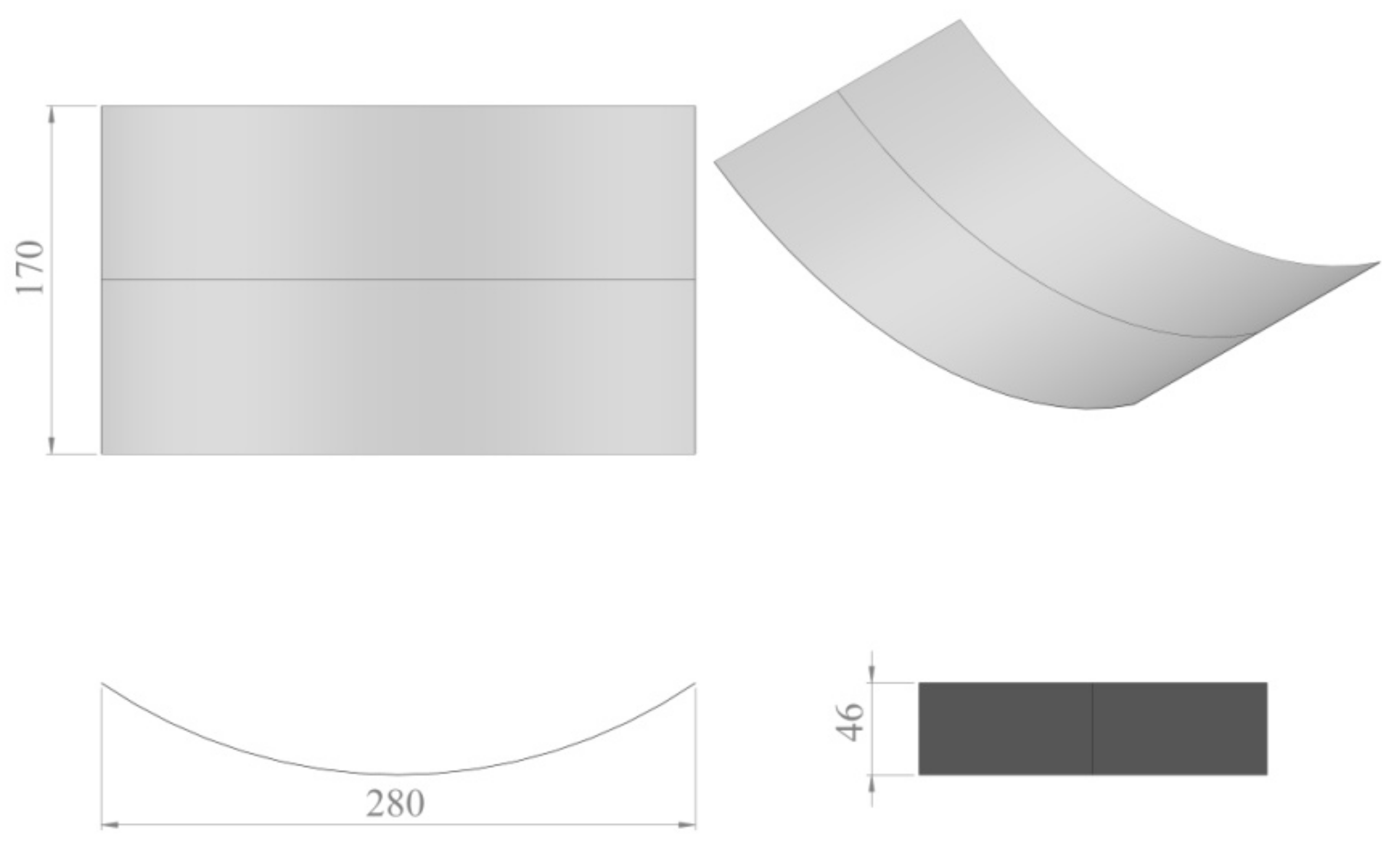

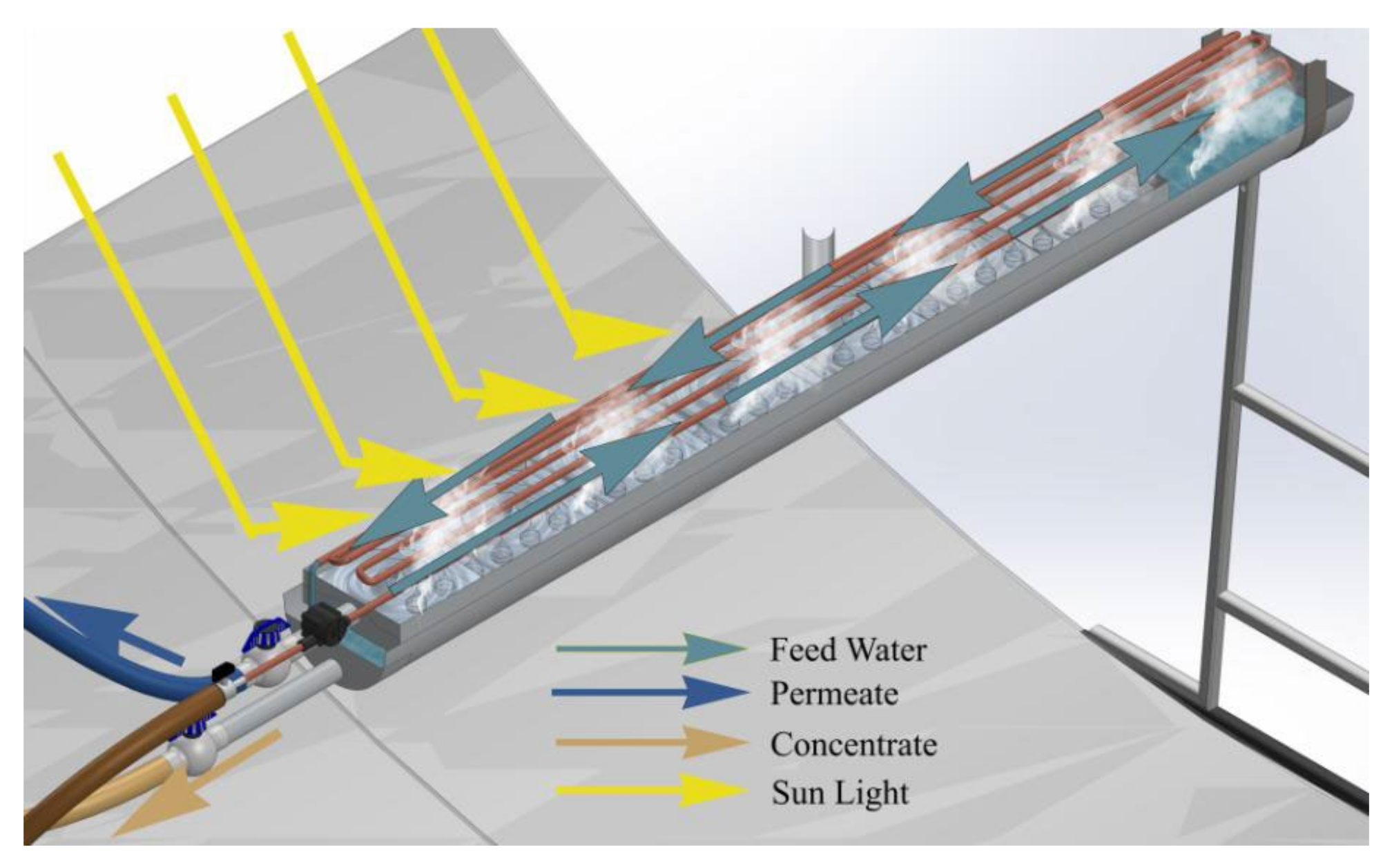
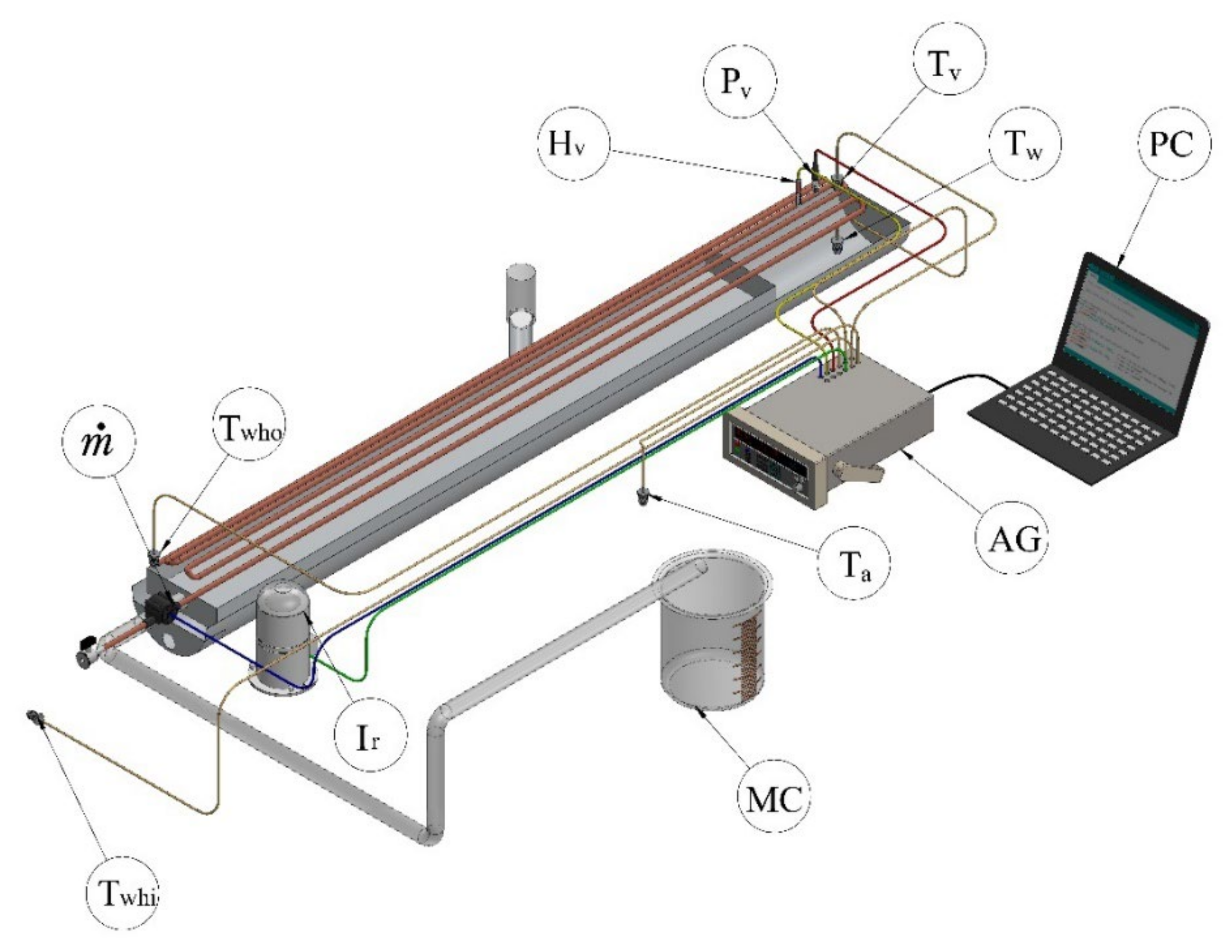
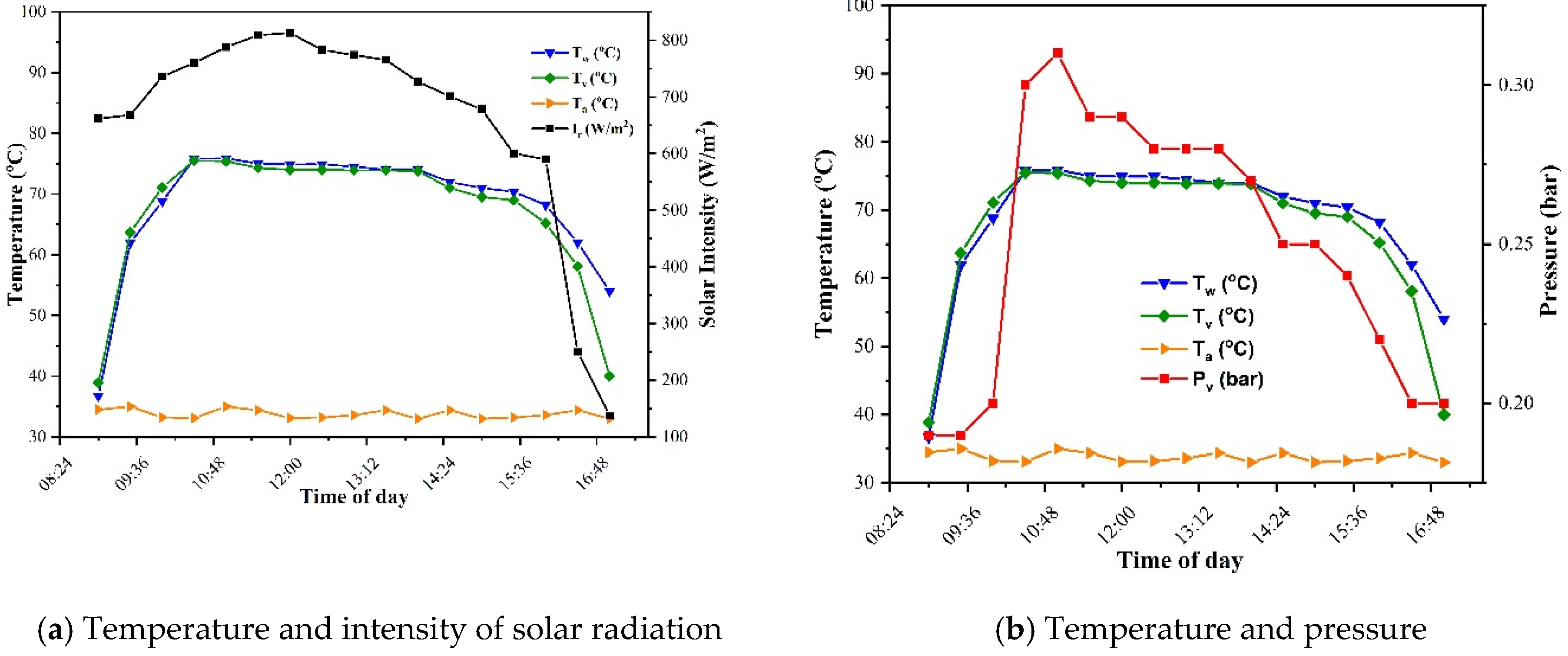

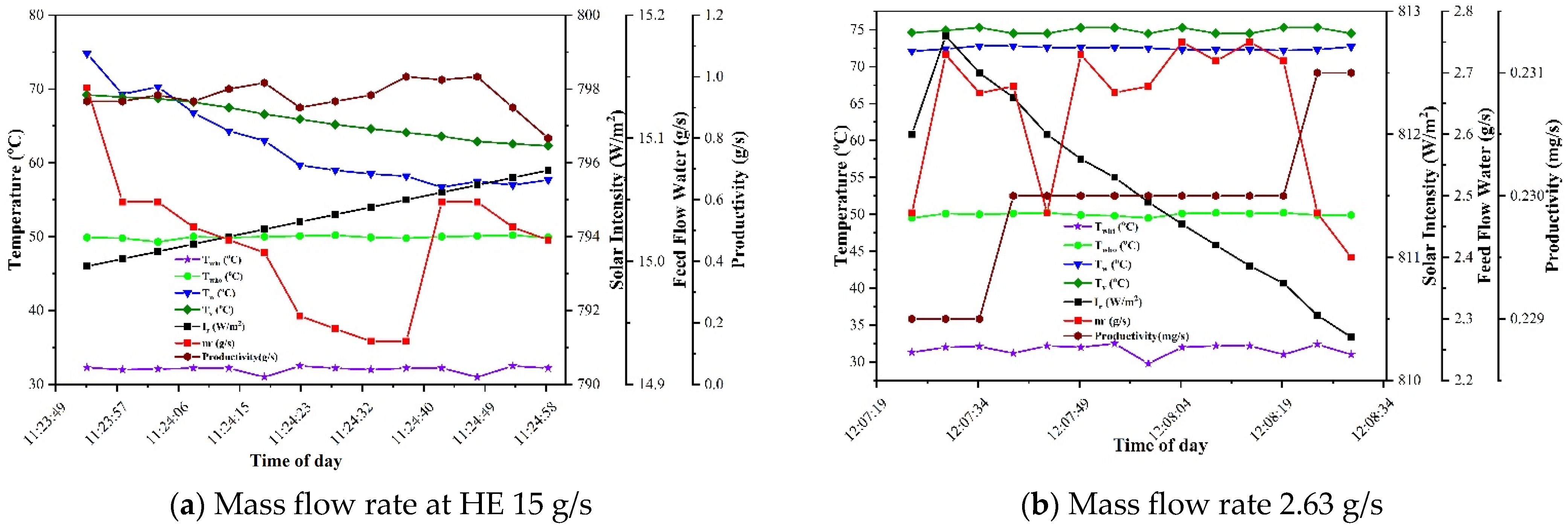
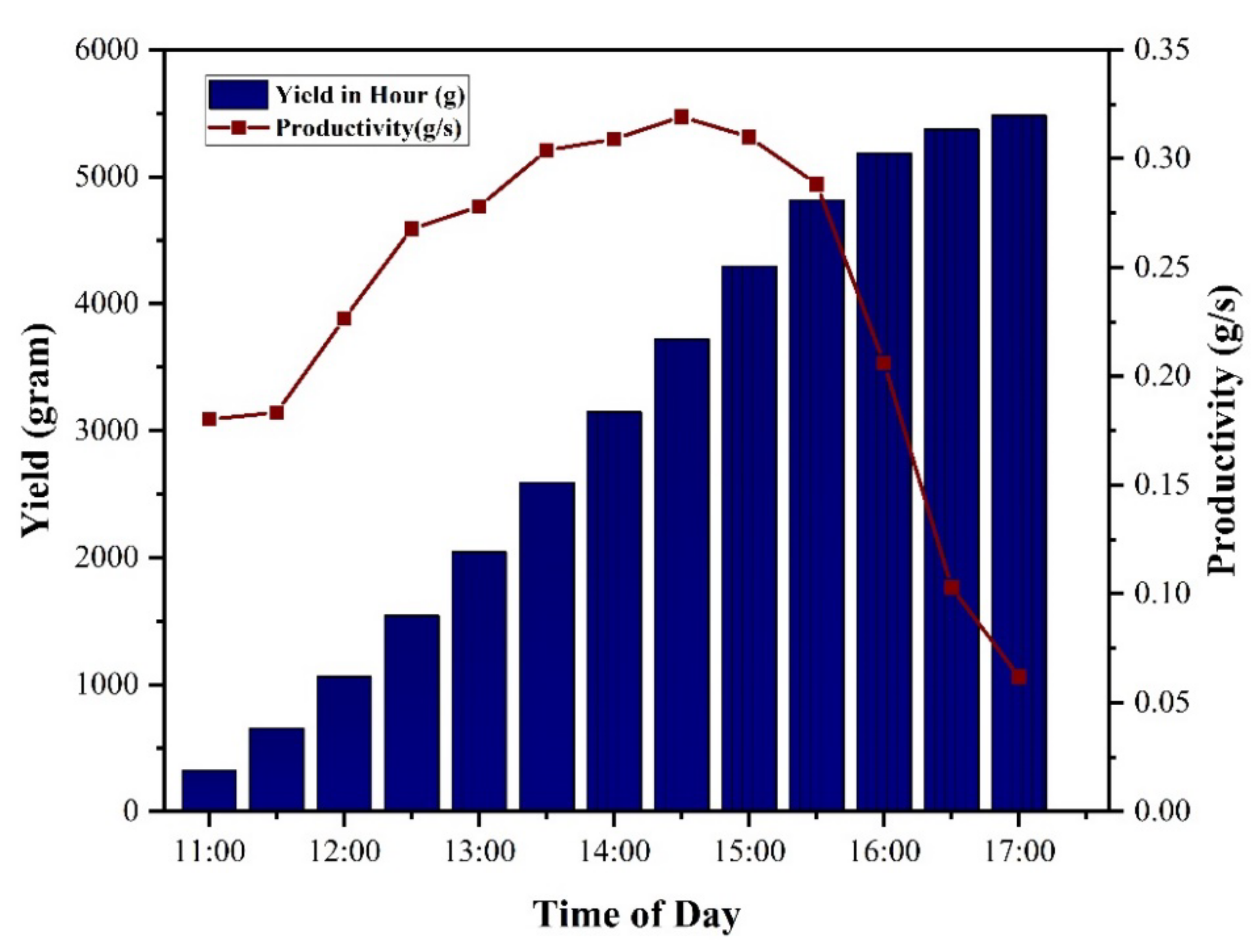
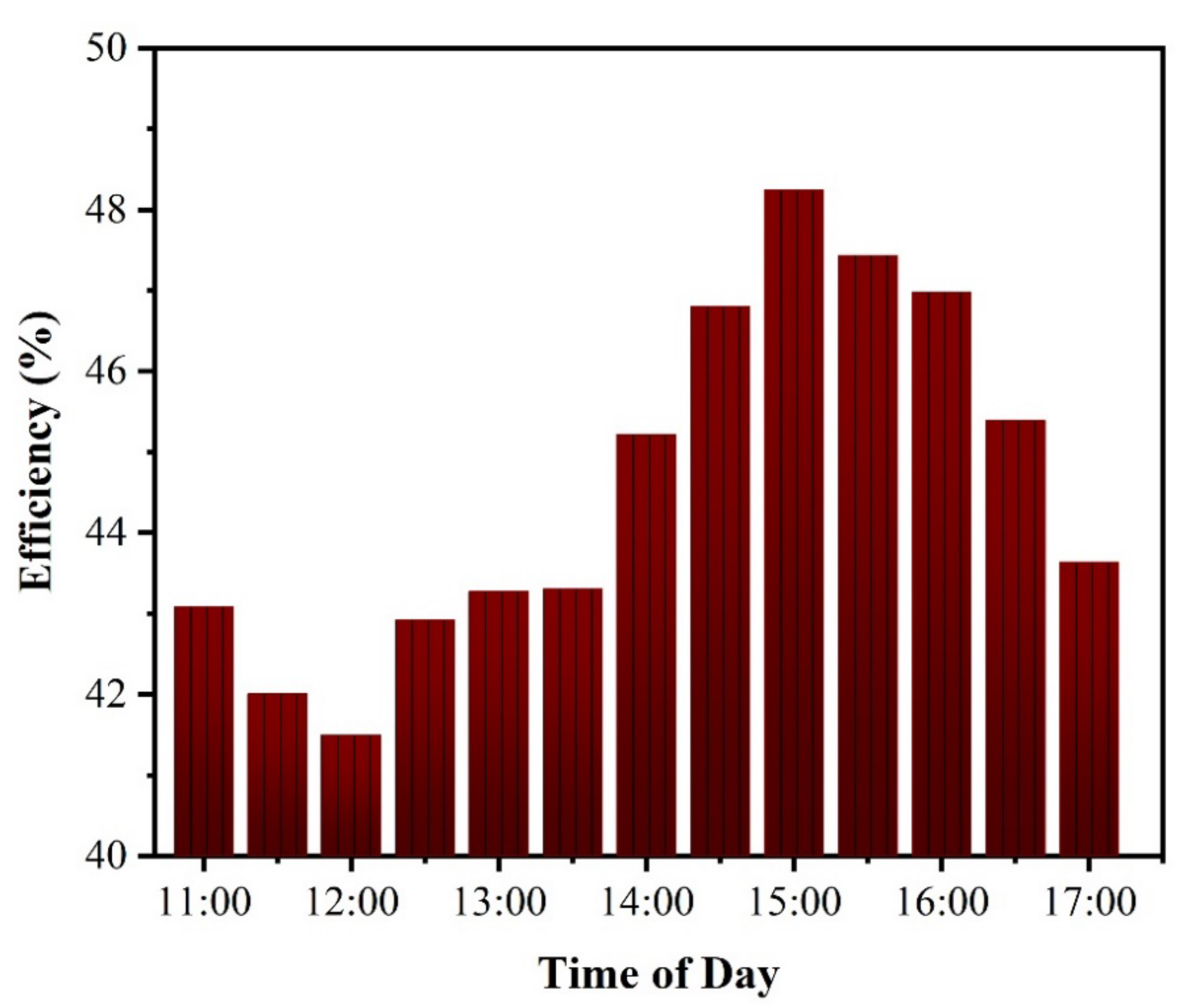
| No | Name of Component | Material | Function |
|---|---|---|---|
| 1 | Tubular | Aluminum | Feedwater heating place |
| 2 | Permeate container | Aluminum | Early permeate shelters |
| 3 | HE | Copper | Steam cooling and feedwater inflow |
| 4 | Sight glass | Glass | Steam cooling and feedwater inflow |
| 5 | Reflector (parabolic trough) | Iron plate | Place for laying solar reflective film |
| 6 | Solar reflective film | Chrome | For the reflector of the sun’s rays |
| 7 | Feedwater valve | - | feedwater flow rate regulator |
| 8 | concentrated valve | - | feedwater flow rate regulator |
| 9 | permeate valve | - | Permeate flow rate regulator |
| 10 | Water pump | - | Flowing feedwater |
| 11 | feedwater tank | HDPE | feedwater storage |
| 12 | Measuring cup | Glass | Final permeate storage |
| 13 | Concentrated tank | HDPE | Concentrate storage |
| Point | Parameters | Unit | Measuring Instruments | Type | Accuracy Level | Range |
|---|---|---|---|---|---|---|
| Twhi | Inlet Feedwater Temperature | °C | Thermocouple | Type K | ±0.1% | −270 to 1260 °C |
| Twho | Outlet Feedwater Temperature | °C | Thermocouple | Type K | ±0.1% | −270 to 1260 °C |
| Tw | Feedwater temperature | °C | Thermocouple | Type K | ±0.1% | −270 to 1260 °C |
| Tv | Steam Temperature | °C | Thermocouple | Type K | ±0.1% | −270 to 1260 °C |
| Ta | Ambient temperature | °C | Thermocouple | Type K | ±0.1% | −270 to 1260 °C |
| Pv | Vapor Pressure | Bar | Pressure Transducer | SEN0257–RK5–2,1B | ±1.5% | 0 to 12 Bar |
| Ir | Solar Radiation | W/m2 | Pyranometer | Sentec (SEM228A) | ±2% | 0 to 1800 W/m2 |
| Mass flow rate | L/s | Flow Meter | YF–S201 | ±1.5% | 1 to 30 L/min | |
| Hv | Vapor Humidity | % | Humidity sensor | FS400–SHT31 | ±0.5% | 0 to 100%RH |
| AG | - | - | Data Acquisition (DAQ) System | Agilent Type A 97410 | ||
| PC | - | - | PC | Free | ||
| MC | Amount of permeate | - | Measuring Cylinder | - |
| (kg/s) | Tw (°C) | (kJ/kg) | Ir (W/m2) | Efficiency (%) |
|---|---|---|---|---|
| 2.68 | 75.90 | 2326.07 | 788 | 43.08 |
| 2.68 | 75.00 | 2328.08 | 809 | 42.00 |
| 2.66 | 74.90 | 2328.30 | 813 | 41.49 |
| 2.65 | 74.91 | 2328.28 | 783 | 42.91 |
| 2.64 | 74.50 | 2329.19 | 774 | 43.27 |
| 2.61 | 74.00 | 2330.31 | 765 | 43.30 |
| 2.59 | 74.00 | 2330.31 | 727 | 45.21 |
| 2.58 | 72.00 | 2334.77 | 701 | 46.80 |
| 2.57 | 71.00 | 2337.01 | 678 | 48.24 |
| 2.57 | 70.4 | 2338.35 | 600 | 47.43 |
| 2.58 | 68.2 | 2343.28 | 590 | 46.97 |
| 2.57 | 62 | 2357.24 | 250 | 45.38 |
| 2.58 | 54 | 2375.39 | 137 | 43.63 |
| S. No | Reference and Author | Design | Area (m2) | Yield (L) | Efficiency (%) |
|---|---|---|---|---|---|
| 1. | Arunkumar et al. [41] | parabolic concentrator-concentric tubular solar still (CPC-CTSS) | 2 | 3.23 | 76.78 |
| 2. | Elashmawy [35] | parabolic concentrator-solar tracking system (PCST-TSS) | 0.059 | 3.53 | 28.5 |
| 3. | Ahmed et al. [42] | parabolic concentrator solar tracking-wicked-tubular solar still (PCST-W-TSS) | 0.87 | 5.1 | 39.7 |
| 4. | Essa et al. [43] | tubular drum solar still (TDSS) with parabolic solar concentrator (PSC) | 0.5 | 5.75 | 63.8 |
| 5. | Kabeel et al. [44] | tubular solar still with a cylindrical parabolic concentrator (CPC) | 1.2 | 7.4 | 60.4 |
| 6. | Present Study | tubular solar distillation device equipped with HE using a parabolic trough the collector | 5.1 | 5.32 | 44.59 |
Publisher’s Note: MDPI stays neutral with regard to jurisdictional claims in published maps and institutional affiliations. |
© 2022 by the authors. Licensee MDPI, Basel, Switzerland. This article is an open access article distributed under the terms and conditions of the Creative Commons Attribution (CC BY) license (https://creativecommons.org/licenses/by/4.0/).
Share and Cite
Amin, M.; Umar, H.; Amir, F.; Ginting, S.F.; Sudarsana, P.B.; Septiadi, W.N. Experimental Study of a Tubular Solar Distillation System with Heat Exchanger Using a Parabolic Trough Collector. Sustainability 2022, 14, 13831. https://doi.org/10.3390/su142113831
Amin M, Umar H, Amir F, Ginting SF, Sudarsana PB, Septiadi WN. Experimental Study of a Tubular Solar Distillation System with Heat Exchanger Using a Parabolic Trough Collector. Sustainability. 2022; 14(21):13831. https://doi.org/10.3390/su142113831
Chicago/Turabian StyleAmin, Muhammad, Hamdani Umar, Fazri Amir, Suma Fachruri Ginting, Putu Brahmanda Sudarsana, and Wayan Nata Septiadi. 2022. "Experimental Study of a Tubular Solar Distillation System with Heat Exchanger Using a Parabolic Trough Collector" Sustainability 14, no. 21: 13831. https://doi.org/10.3390/su142113831







